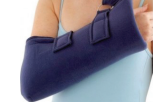Download and print as a PDF (916kB pdf)
On this page
Triangular bandages are typically used for immobilising injured limbs, but often used to secure splints or dressings. If you have suffered an injury to your shoulder, elbow, or wrist, you may be asked to wear a sling to help protect your arm while it heals. Wearing a sling keeps your arm against your body and prevents you from moving your arm too much the injury heals.
It is important to periodically (ideally every hour) remove the arm from the high arm sling and exercise it. This will help prevent the shoulder, arm and fingers becoming stiff.
The exercises should be completed carefully and slowly:
• Bend and stretch the injured arm.
• Rotate the upper arm and shoulder.
• Touch the back of your head (within the limits of mobility).
• Touch your lower back (within the limits of mobility).
• Wiggle your fingers.
Slings
Slings are used to support and protect injured arms, wrists and hands. There are two types of sling: the broad arm sling and the high arm sling.
Broad arm sling
The hand should be slightly higher than the elbow, when correctly applied. The base of the sling should lie at the base of the little finger, leaving the fingernails exposed.
This is used to give support to:
• an injured upper arm.
• an injured wrist or forearm.
• someone who can bend their elbow.
• someone with a rib fracture.
Poly Sling
This is used for clavicle fractures or radial head fractures. This type of sling is more substantial for injuries that need more support.

High arm sling
This is used to support the hand and forearm in a well-raised position, with the fingertips touching the opposite shoulder. This helps to:
• support the arm with an injury or infection.
• control bleeding from wounds in the forearm or hand.
• reduce swelling.
Reef knot
Always tie the ends of the sling with a reef knot, as it lies flat, will not slip and is easy to untie. Make sure the knot does not press onto a bone or into the skin at the back of the neck.
Check for problems
• Change of colour to hands / fingers (blue or white).
• Numbness or ‘pins and needles’ in your hand or fingers.
• Redness, soreness or swelling of the skin around the sling.
• Increased pain whilst wearing the sling arm sling.
Bandages
These maintain direct pressure over a dressing to control bleeding, hold dressings or splints in position, provide support for a limb or joint and occasionally are used to restrict movement. They should be firm enough to hold the dressing in position, control the bleeding or prevent movement, but not so tight that it interferes with the circulation.
Make sure you check your bandages frequently to make sure they are not becoming too tight as the tissues swell. Bandages should be applied evenly to prevent swelling at either end.

General support
• For general medical advice please use the NHS website, the NHS 111 service, walk-in-centres, or your GP.
• NHS website provides online health information and guidance.
• There are walk-in and urgent treatment services at Brighton Station, Crawley Urgent Treatment Centre, Lewes Victoria Hospital, Horsham Minor Injuries Unit and Bognor Regis War Memorial Hospital.
The information in this leaflet is for guidance purposes only and is in no way
intended to replace professional clinical advice by a qualified practitioner.